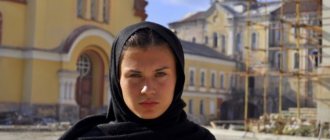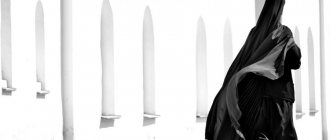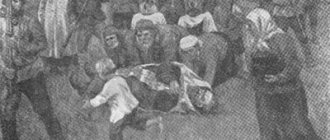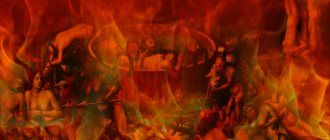Archpriest Vladimir Dolgikh answers.
If one of our fellow citizens is asked to draw a verbal portrait of an Orthodox priest, then he may forget (or not know) about some parts (elements) of the vestment, but no one will forget about the beard. Moreover, the beard will be what he remembers first. The statement that priests wear beards has already become so ingrained in our consciousness that not everyone can answer directly: why priests wear beards. It just so happened, and if someone happens to see a beardless priest in vestments, then one cannot do without slight disorientation and an attack of cognitive dissonance.
So, why do priests wear beards? Many, probably, on reflection, will refer to the image of Jesus Christ, which we see on icons, and will point out that this is how the imitation of the appearance of the Savior is manifested. Of course, this is one of the reasons, but not the only one.
Beard in Scripture
Even those who have not particularly delved into the texts of the Holy Scriptures can guess that the wearing of a beard by priests has ancient Old Testament roots. And indeed, in the 19th and 21st chapters of the Book of Leviticus we will see the direct command of the Lord not to cut our heads and beards. There are reasons for this as well. The non-canonical Epistle of Jeremiah, in the very first chapter, tells us that shaving heads and beards was characteristic of pagan priests, which is why the Mosaic Law was aimed at restraining Jewish priests from idolatrous practices. St. Ephraim the Syrian clarifies that the pagans specially grew hair on their heads and faces, in order to then cut them off at a specially appointed time at “sacred” sources or directly at the temples themselves. Thus, shaving heads and beards was not just a tradition, but part of idolatrous mystery cults. We understand perfectly well that Christ abolished the Old Testament ritual law, therefore in the New Testament we will not find such commands regarding wearing a beard, but there is another side to this issue.
How not to make a mistake
If you are not sure in what compositions the models will be combined with a short beard cut, then it makes sense to pay attention to the theory of archetypes, which will most accurately suggest the style and shape of the haircut. The personality type and behavior pattern in society are represented by varieties: wanderer or rebel, warrior or guardian, lover or jester, magician or creator, as well as other types. By analyzing behavioral factors and combining them with fashion trends, it is easy to select hairstyles and beard shapes. For example, long hairstyles with short stubble are suitable for the Wanderer type. “Lover” will not fit the model version of “Warrior”, and “Rebel” will look ridiculous in the image of “Philosopher”. At the same time, it will look harmonious with the “Iroquois” and the “French Fork”.
Whatever the choice of hairstyle in combination with a beard, everything is individual. The main thing is to like yourself and always be irresistible, to be able to correctly present your image and maintain your style
Each new image of a man is completed with clothes of a business or romantic style. There are a huge number of stylists and barbers working in Moscow who will select a spectacular haircut to suit the shape of the beard. Professionals are involved in creating a harmonious image, so we recommend that before going to the hairdresser, choose a great specialist and develop several images: for work, on vacation, for the weekend. It is they who will advise the optimal combination of suit, hairstyle and beard for your appearance and inner content.
Beard in the canons
In the first book of the “Apostolic Constitutions” (paragraph 4) it is said that he who wants to please others “bares his beard.” Approximately the same idea is heard in the 96th rule of the Sixth Ecumenical Council. It says that those who have put on Christ must imitate His life, and hence avoid weaving and specially styling their hair, with which they tempt fragile souls. Zonara in his interpretation explains that this rule also applies to a beard, but here again there are reasons. At that time, men braided their hair and shaved their beards in order to appear gentle and more like women. As you may have guessed, in this case we are talking about the homosexual traditions of the ancient Roman Empire. In order to distance itself from such associations, the Church introduces a ban on manipulation of hair, which was a sign of prodigal vices.
As we understand, since those times the tradition of wearing a beard has become so ingrained that now priests wear a beard, as modern programmers would say, by default.
Subsequently, the idea of the similarity of a beardless man with a woman migrated to the definitions of the Stoglavy Council (1551). But, apparently, in the 16th century, the absence of a beard on a man seemed so unnatural that the Council’s definitions even contained a ban on funeral services and any other prayers in the church for the repose of the souls of those who dared to shave their beards.
This is probably why the Orthodox beard in Ukraine, Russia, Belarus, in general, in Slavic countries, acquired a semantic connection with such concepts as might, strength, will, and other attributes of masculinity.
What does the church prescribe?
Why do Orthodox priests wear a beard? This is prescribed by the church. But a bearded priest, also with long hair, should look neat. Who would like a shaggy clergyman with long unwashed hair? Moreover, with an unkempt long beard? Of course, parishioners are unlikely to be drawn to such a priest.
What should a priest look like? Long hair is collected in a ponytail. Your head is always clear. The beard is neatly combed and has a shape despite its length. But taking care of your hair and beard should not go to extremes. Both unkemptness and excessive “lickiness” would be inappropriate.
Can a priest not wear a beard?
Theoretically, of course, it can, but practically the beards of Orthodox priests have become an integral feature of their appearance. Abroad, the situation is sometimes a little different. As we know, the majority of Latin clergy do not wear beards, since from early Christian times this was considered an indication of belonging to the highest social strata of ancient Roman society, gradually this tradition took root and became generally accepted in the West. But when Europe and the United States in the 60s and 70s of the twentieth century were covered by the popularity of the hippie movement, some Orthodox priests began to shave their beards. Representatives of hippies took and distributed drugs, became famous for other violations of the law, and one of the signs of their appearance was a beard. So, the priests were simply tired of being constantly detained by the police, who perceived the presence of a beard as an attribute of belonging to hippies.
Today we see that not only clergymen, but also many men have begun to wear beards. But if for people far from the Church this is a tribute to fashion, then for the Orthodox the beard has become a symbol of the desire to imitate Christ. Therefore, answering the question: why do the Orthodox have beards, a reference to the fact that our Savior wore a beard will suffice. Although we, of course, understand perfectly well that our spiritual life, and especially eternity, in no way depends on the presence or absence of facial hair.
Archpriest Vladimir Dolgikh
Interesting tradition
Already in the 17th century in Rus', priests combined two traditions: cutting the gumenzo and growing hair together with a beard. Thus, the top of the head was shaved smooth, and the remaining long hair was braided. The shaved part of the head was covered with a special cap - skufya. Why do Orthodox priests wear long hair? More on this in the next paragraph.
How was a beard treated in Old Testament times?
In the Old Testament law there was a requirement, although not unconditional, about the prohibition of barber shaving (Lev. 19:27). In some cases, shaving the beard could result in dishonor and disgrace (1 Chronicles 19:4–5), but not always (Lev. 14:9). The ancient Jews paid a lot of attention to the beard (Ps. 133:2). It was considered a great insult if someone, being irritated or to express his anger, contempt, plucked his opponent’s beard or grabbed it, sometimes this was done with the aim of “bringing to his senses” the opponent, the enemy (Neh. 13:25), kissing the beard, on the contrary, served as a special sign of respect and friendship. Pulling out hair from a beard, or completely removing it and neglecting its decent appearance served as a sign of deep sadness (1 Ezra 9:3, Isaiah 15:2, Jer. 41:5, Jer. 48:37), instead of cutting the beard as a sign grief could also be limited to covering your beard. An unkempt, unkempt beard could also be considered a sign of a person’s insanity (1 Samuel 21:13–15).
Why Baptists Avoid Crosses
Many people know that Baptists follow the commandment, which says that one must avoid worshiping anything or anyone. According to them, it became like an object of worship for believers who belong to Christianity. These people believe that Jesus Christ is part of God. And according to the Bible, Jesus is not God, but rather like God. Jesus is the son of God, he is the firstborn, which means he has a beginning, while God has no beginning. In addition, a very important fact for Baptists is that the Bible does not clearly indicate that believers should wear a cross.
Reference! According to Baptists, the cross is a symbol of crucifixion and torture, because Jesus Christ was executed on it by the Roman legions.
Maxim Isaev
Doctor of Law, Professor of the Department of Constitutional Law at MGIMO:
– I’ve had a beard since 2004. I started going with her after I defended my doctorate. We can say that the specifics of my work contributed to the appearance of the beard.
Women don't like beards - they are frivolous! For an Orthodox man, a beard is a certain dignity and meaning of his worldview. Being with a beard, he takes on certain obligations - first of all, to conform to the image of the Lord our God, because the Lord created us in his image. And if we look at the iconography, our Lord Jesus Christ is depicted everywhere with a beard. Therefore, we must strive to conform to Him.
One can recall many historical examples when Orthodox people found themselves in captivity, forced into an infidel way of life, but, nevertheless, remained Orthodox. And the beard in this case is part of the Orthodox tradition. I can’t even imagine a metropolitan, excuse me, with a bareface, neither here nor among the Greeks. This is possible among Catholics and Protestants, but they have different traditions.
In our climate, a beard can be very useful - it warms you up in cold weather. The only negative is that it takes a long time to comb in the morning.
The image of a priest in Orthodoxy
We found out why priests wear beards. What is he like, an Orthodox priest? He strives to be like Christ, for the priest is the earthly model for Christians. Isn't this one of the reasons for wearing long hair and a beard? Not a single icon depicts the Savior without a beard or long hair.
The priest wears a special vestment and cassock. The cassock is a kind of dress with very wide sleeves, usually black. But there may also be summer versions of this clothing - light ones. When it is very hot, wearing a black cassock is far from comfortable.
White clergy, that is, married priests, wear skufia - a special cap. The black clergy - monks - are dressed in cassocks and hoods. The hood is a tall black “hat” with a veil at the back. The blanket goes along the back and down to the floor. An indispensable attribute of monasticism, with the exception of a beard and long hair, is a rosary. The monks pray for them. Lay priests may also wear rosaries.
So, a representative of the white clergy looks like this:
- Vestment and cassock.
- A large cross on a massive chain on the chest.
- Long hair and beard.
- Sometimes - a prayer book in hand and a rosary.
Is it forbidden for priests to shave their beards?
The beard of priests is one of the symbols of faith. The Orthodox beard was mentioned even in the Old Testament, but not just like that, but with the special instructions of God.
Every man is obliged to grow facial hair, as it is written in the Bible. The Lord ordered not to cut the hair on the head and not to trim the edges of the beard.
Attention! Women, in turn, were also forbidden to cut their hair.
This is due to the fact that every person should look the way he was created. Changing one's appearance is equivalent to failure to fulfill the will of God. People do not follow such an order, but among the priests it is considered a ban. The clergy, living according to Biblical laws, diligently follow what is written in the Bible. This is why they don't shave their beards.
Beards among priests are a common and commonplace phenomenon. Most people don't even think about the fact that priests have facial hair for a reason. What seems unreasonable to the average person actually turns out to be a whole story.
ISLAM
Muhammad said: “Shave your mustache and grow your beard”; “Don't be like the pagans! Shave your mustache and grow your beard"; “Cut your mustache and grow your beard. Don’t be like fire worshipers!”
The Koran forbids shaving the beard. Shaving a beard is a change in the appearance of Allah's creation and submission to the will of Shaitan. Growing a beard is a natural property bestowed by Allah; touching it is not commanded and shaving it is prohibited. Muhammad said: “Allah has cursed men who imitate women.” And shaving a beard is likened to a woman.
One of the hadiths about the Prophet Muhammad says that he received an ambassador from Byzantium. The ambassador was clean-shaven. Muhammad asked the ambassador why he looked like that. The Byzantine replied that the emperor forces them to shave. “But Allah, He is Almighty and Great, ordered me to leave my beard and trim my mustache.” During the ensuing diplomatic conversation with the ambassador, Muhammad never looked at the shaven ambassador again because he treated him as an effeminate creature.
In Islam, a beard is an obligation and cutting it completely is prohibited. However, there are cases where shaving the beard is permitted (for example, if you are traveling to a country where wearing a beard may result in persecution). But be that as it may, prolonged shaving of the beard is a great sin (kabira).
Beard fashion in Rus'
The significance of the Russian beard strengthened after the Epiphany in Rus' in the 10th century. Until this moment, beards were not worn as a religious cult. Since then, the beard has become a symbol of faith, spirit, everything was done according to the model of the Byzantine clergy. Christ and the apostles and the ancient biblical prophets were cited as examples. As a result, it turned out that the church approved the folk tradition, making it at the same time a symbol of Russian nationality and faith.
The Russian beard was under the protection of the state. Prince Yaroslav even issued a decree according to which a fine was established for damaging a beard. Also, if the ancestors wanted to offend an ambassador or an enemy, they shaved off his facial hair. There was no insult worse than this at that time. Beards were still forcibly shaved off for fornication.
Many Russian rulers were remembered for their special protection of their beards. Ivan the Terrible was of the opinion that shaving a beard is such a great sin that it cannot be washed away even with the blood of martyrs. This opinion was actively supported by the priests; they did not even bless men without a beard.
Persons who damaged beards had to pay heavy fines, this was considered a very serious offense
The fine was 12 hryvnia - this is only three times lower than the fine expected for killing a person. In the 17th century and during the Time of Troubles, shaving facial hair was associated with Catholicism and was considered a Western custom. For example, False Dmitry I shaved, and the absence of a beard looked like a betrayal of the Orthodox Church and served as sure proof of imposture.
CATHOLICISM
Catholic clergymen are ordered not to have a free-growing beard: Clericus nec comam nutriat nec barbam. The interpretation of this prescription was different in different periods. It is known that from the 16th to the 18th centuries many Popes had beards! (Julius II, Clement VII, Paul III, Julius III, Marcellus II, Paul IV, Pius IV, Pius V).
Pope Julius II was the first to grow a beard in 1511. Despite the fact that his most famous portrait is with a beard, he did not break the custom for long - only for a year. He grew his beard as a sign of grief. After him, several more dads did not even think about wild facial hair.
Pope Julius II
However, the resonance of Julius II's actions was felt throughout the years, and Pope Clement VII grew a luxurious beard in 1527, which he did not shave until his death in 1534. He was treacherously poisoned, feeding the unsuspecting pontiff pale toadstool for sympathy with France.
Pope Clement VII
Subsequent Popes decided that a beard was beautiful and godly and proudly wore facial hair for more than two centuries. Pope Alexander XVII, however, gave his beard a refined and more modern shape (mustache and goatee, the same shape of beard and mustache was followed by subsequent Popes) - his papacy lasted from 1655 to 1667.
Pope Alexander VII
Pope Clement XI interrupted the glorious tradition (note that Clement VII started it). He ascended the throne on November 23, 1700.
Pope Clement XI
In general, at first in the Roman Church there were no canonical rules regarding whether to wear a beard or not, and earlier Popes considered it their duty to grow a beard - starting from the Apostle Peter, few of them even thought about shaving their facial hair. This was the case until the Great Schism in 1054.
Even in ancient times, the Romans were accustomed to seeing a beard as a symbol of barbarism. Perhaps this was the reason for the penchant of Catholic clerics for a clean shave.
In the Western Church, one of the symbols of priestly service was tonsure - hair cut in a circle on the top of the head.
In the Russian tradition, an analogue of the tonsure was
the humenzo (a circle on the head, symbolizing the crown of thorns).
The shaved part was covered with a small cap called “gumenets” or “skufia”. The custom of cutting the gumenzo existed in Russia until the middle of the 17th century. In Catholicism, a clergyman is required to shave his beard - a smooth face is considered a symbol of holiness, and in some monastic orders tonsure is also accepted - a shaved nape.











